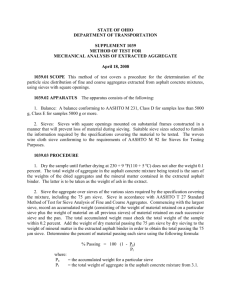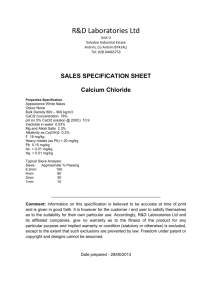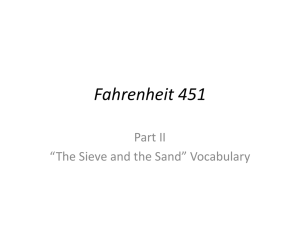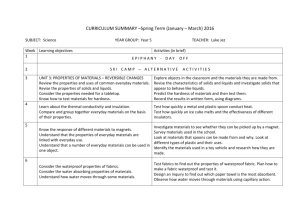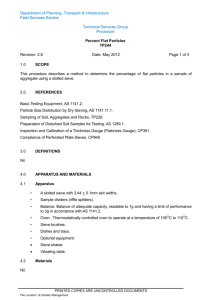DETERMINATION OF WATER CONTENT :
advertisement
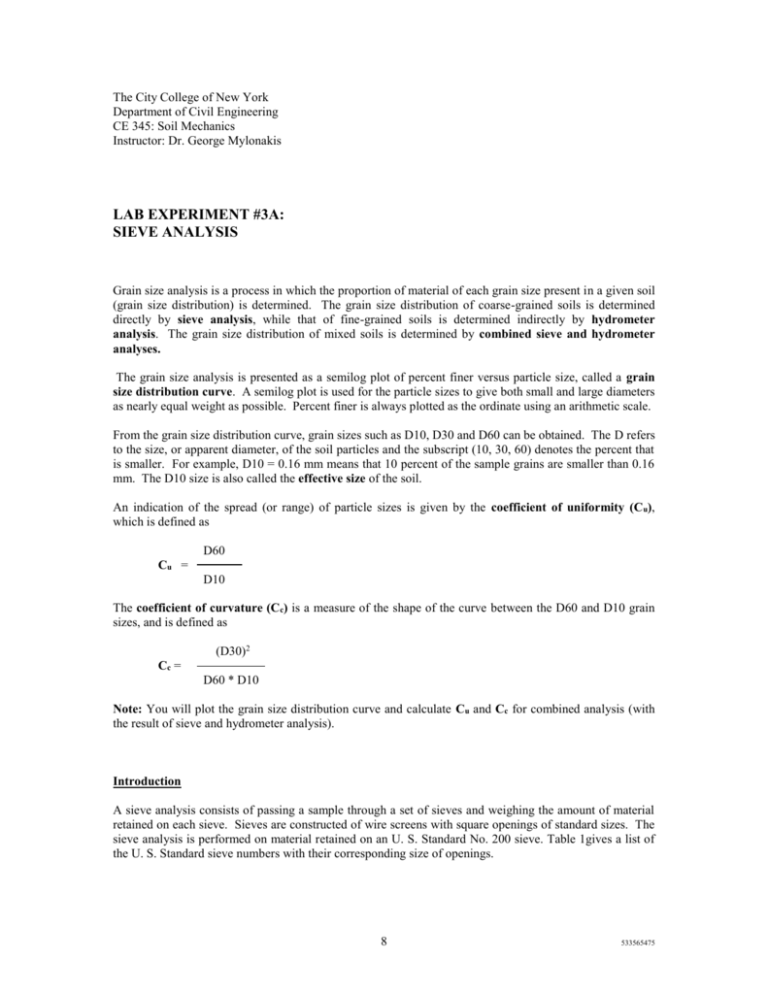
The City College of New York Department of Civil Engineering CE 345: Soil Mechanics Instructor: Dr. George Mylonakis LAB EXPERIMENT #3A: SIEVE ANALYSIS Grain size analysis is a process in which the proportion of material of each grain size present in a given soil (grain size distribution) is determined. The grain size distribution of coarse-grained soils is determined directly by sieve analysis, while that of fine-grained soils is determined indirectly by hydrometer analysis. The grain size distribution of mixed soils is determined by combined sieve and hydrometer analyses. The grain size analysis is presented as a semilog plot of percent finer versus particle size, called a grain size distribution curve. A semilog plot is used for the particle sizes to give both small and large diameters as nearly equal weight as possible. Percent finer is always plotted as the ordinate using an arithmetic scale. From the grain size distribution curve, grain sizes such as D10, D30 and D60 can be obtained. The D refers to the size, or apparent diameter, of the soil particles and the subscript (10, 30, 60) denotes the percent that is smaller. For example, D10 = 0.16 mm means that 10 percent of the sample grains are smaller than 0.16 mm. The D10 size is also called the effective size of the soil. An indication of the spread (or range) of particle sizes is given by the coefficient of uniformity (C u), which is defined as D60 Cu = D10 The coefficient of curvature (Cc) is a measure of the shape of the curve between the D60 and D10 grain sizes, and is defined as (D30)2 Cc = D60 * D10 Note: You will plot the grain size distribution curve and calculate Cu and Cc for combined analysis (with the result of sieve and hydrometer analysis). Introduction A sieve analysis consists of passing a sample through a set of sieves and weighing the amount of material retained on each sieve. Sieves are constructed of wire screens with square openings of standard sizes. The sieve analysis is performed on material retained on an U. S. Standard No. 200 sieve. Table 1gives a list of the U. S. Standard sieve numbers with their corresponding size of openings. 8 533565475 Table 1. U. S. Sieve Numbers and Associated Opening Sizes Sieve No. Opening Size (mm) Sieve No. Opening Size (mm) 4 5 6 7 8 10 12 14 16 18 20 25 30 4.75 4.00 3.35 2.80 2.36 2.00 1.70 1.40 1.18 1.00 0.85 0.71 0.60 35 40 45 50 60 70 80 100 120 140 200 270 400 0.500 0.425 0.355 0.300 0.250 0.212 0.180 0.150 0.125 0.106 0.075 0.053 0.038 Apparatus 1. Sieves, a bottom pan and a cover 2. A balance sensitive to 0.1g 3. Mortar and rubber pestle 4. Oven 5. Mechanical sieve shaker 6. Paint brush for cleaning sieves 7. Sample splitter or riffle Preparation of sample The material to be treated is first air-dried, after which the aggregates present in the sample are thoroughly broken up with the fingers or with the mortar and pestle. The specimen to be tested should be large enough to be representative of the soil in the field. It should also be small enough not to overload sieves. Large soil samples are divided by using a riffle to preserve their grain-size distribution. The size of a representative specimen depends on the maximum particle size. Table 2 gives some guidelines for selecting the minimum sample weight. 9 533565475 Table 2. Minimum Sample Weights for Sieve Analysis Maximum particle size (cm) Minimum weight of sample (g) 7.5 5.0 2.5 1.0 Finer than No. 4 sieve Finer than No.10 sieve 6000 4000 2000 1000 200 100 Procedure 1. Collect a representative oven-dry soil sample. Samples having largest particles of the size of No. 4 sieve opening (4.75 mm) should be about 500 grams. For soils having largest particles of greater than 4.75 mm, larger weights are needed. 2. Break the soil sample into individual particles using a mortar and a rubber-tipped pestle. (Note: The idea is to break up the soil into individual particles, not to break the particles themselves.) 3. Determine the mass of the sample within 0.1g (W). 4. Prepare a stack of sieves. A sieve with larger openings is placed above a sieve with smaller openings. The sieve at the bottom should be a No. 200. A bottom pan should be placed under the No. 200 sieve. The sieves that are generally used in a stack are Nos. 4, 10, 20, 40, 60, 140 and 200; however, more sieves can be placed in between. 5. Pour the soil prepared in Step 2 into the stack of sieves from the top. 6. Place the cover on the top of the stack of sieves. 7. Run the stack of sieves through a sieve shaker for about 10 to 15 minutes. 8. Stop the sieve shaker and remove the stack of sieves. 9. Weigh the amount of soil retained on each sieve and the bottom pan. If a considerable amount of soil with silty and clayey fractions is retained on the No. 200 sieve, it has to be washed. Washing is done by taking the No.200 sieve with the soil retained on it and pouring water through the sieve from a tap in the laboratory. When the water passing through the sieve is clean, stop the flow of water. Transfer the soil retained on the sieve at the end of washing to porcelain evaporating dish by back washing. Put it in the oven to dry to a constant weight. Determine the mass of the dry soil retained on the No. 200 sieve. The difference between this mass and that retained on the No. 200 sieve determined in Step 9 is the mass of soil that has washed through. 10 533565475 Calculation 1. Calculate the percent of soil retained on the nth sieve (counting from the top ) Rn = Mass retained, Wn _______________________ x 100 Total mass, W ( Step 3 ) 2. Calculate the cumulative percent of soil retained on the nth sieve n Rn i=1 3. Calculate the cumulative percent passing through the nth sieve n percent finer =100 – Rn i=1 Note : If soil retained on No. 200 sieve is washed, the dry unit weight determined after washing (Step 10) should be used to calculate percent finer (than No. 200 sieve). The weight lost due to washing should be added to the weight of the soil retained on the pan. 11 533565475 DATA SHEET: Sieve Analysis Description of soil: Date: ________________________ ______________________________________ Location: _______________________________ Tested By (Group): Sample No: ________________________ _______________________________ Mass of oven dry sample (W): Sieve No. Sieve opening (mm) _________________g Mass of soil retained on each sieve (Wn) Percent of mass retained on each sieve (Rn) Cumulative percent retained, Rn Percent finer, 100 - Rn Bottom Pan W1 = Wn = ______________ Mass loss during sieve analysis = (W - W1) X 100 / W = _________ % (OK if less than 2%) 12 533565475
